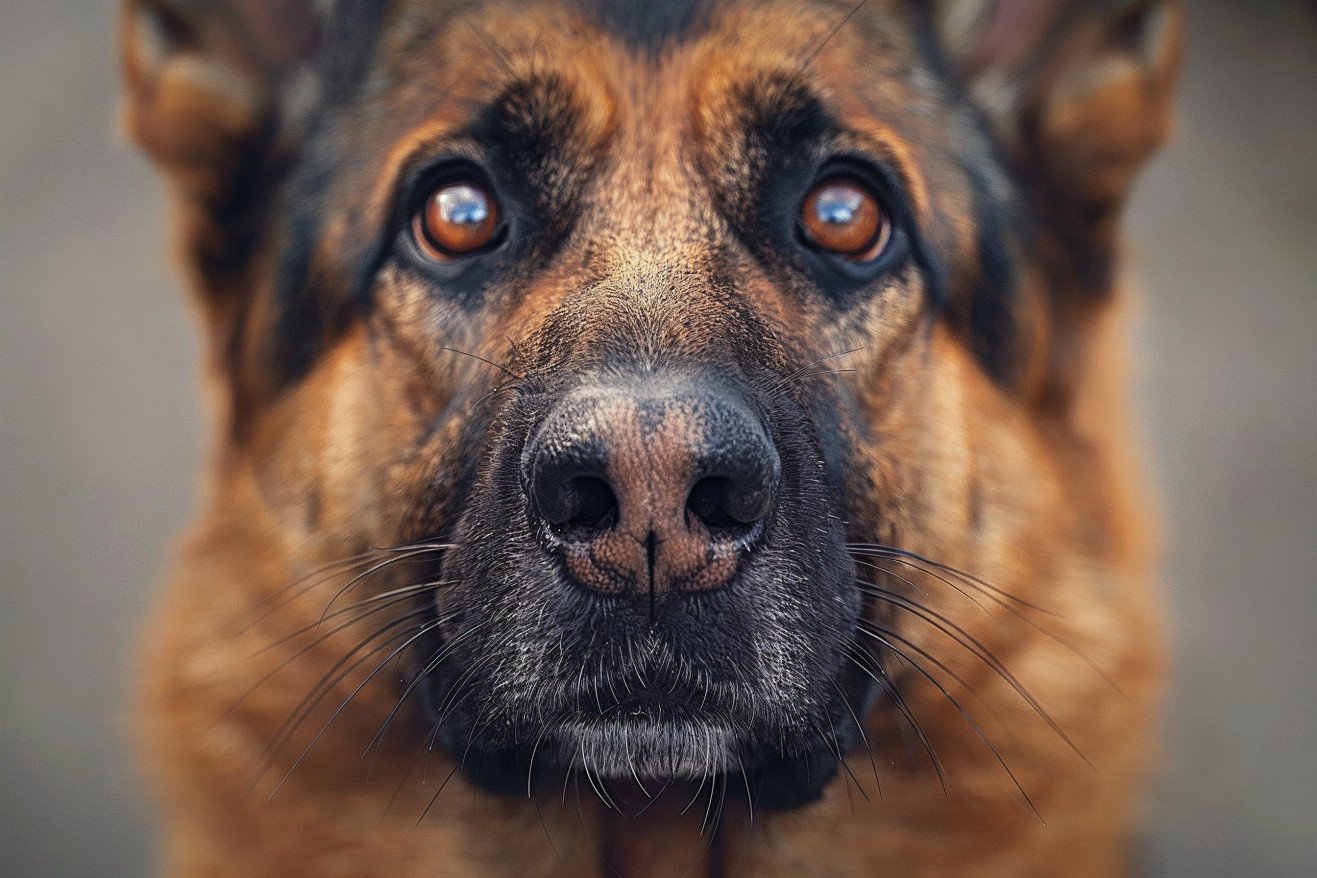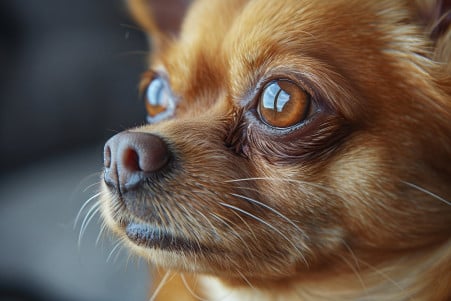Is It Ever OK to Trim Your Dog's Whiskers? What Vets Say
23 April 2024 • Updated 21 April 2024

Are you thinking about trimming your dog's whiskers, or are you wondering if it's safe to do so? While it's not recommended to cut a dog's whiskers because they have an important purpose, it's generally safe to trim long whiskers as long as you're careful not to cut too close to the hair follicle. That said, whiskers help dogs with their spatial awareness, so it's best to leave them alone if you can.
To help you understand the importance of whiskers and whether or not you should trim them, we referenced veterinary professionals and looked at scientific research on dog senses and behavior. This information will help you understand how dogs use their whiskers to navigate the world, communicate, and learn about their environment. You'll be able to decide whether or not to trim your dog's facial hair in a way that's safe and ethical.
Is it ever okay to trim your dog's whiskers?
The Anatomy and Functions of Dog Whiskers
Dog whiskers, scientifically known as vibrissae, are far more than just facial hair. These specialized tactile hairs have a unique anatomical structure that equips dogs with an extraordinary ability to sense their surroundings. According to WebMD, whiskers are longer, thicker, and more rigid than regular fur, with tapered tips and deep roots containing numerous nerve endings.
Dogs possess four distinct types of whiskers, each serving a specific purpose. The mystacial whiskers on the muzzle and upper lip are the most noticeable, while the supraorbital whiskers above the eyes act like eyebrow sentinels. The genal whiskers on the cheeks aid peripheral vision, and the interramal tufts below the chin help sense objects underneath the face, as highlighted by PetMD.
These tactile hairs play a crucial role in helping dogs navigate their environment. When whiskers make contact with surfaces or air currents, the nerve receptors in their follicles transmit signals to the dog's brain, allowing them to detect nearby objects, measure distances, and even sense changes in temperature and wind speed, according to the American Kennel Club. Whiskers act as an early warning system, preventing collisions and enabling navigation in low-light conditions.
Moreover, whiskers are not just sensory tools; they also convey a dog's emotional state. As noted by PetMD, relaxed dogs often have their whiskers resting flat against their face, while scared or threatened dogs may flare or twitch their muzzle whiskers outward and downward. This intricate anatomy and multifaceted functionality highlight the importance of preserving a dog's whiskers for their well-being and ability to interact with their environment.
What Happens When Dog Whiskers Are Cut or Trimmed?
There are several potential consequences to cutting or trimming a dog's whiskers. According to Business Insider, removing a dog's whiskers can cause disorientation and make it difficult for the dog to get around. This can result in anxiety, stress, and confusion, and even cause the dog to run into things.
The Quora post explains that whiskers are highly sensitive and part of a dog's nervous system, so cutting them can be painful and stressful. This is especially concerning for dogs with vision problems or those who rely on their whiskers to help them understand their environment.
Moreover, another Quora post suggests that if a dog's whiskers are frequently falling out or are brittle, it could be a sign of an underlying health problem that needs to be checked out by a vet. While cutting a dog's whiskers may not be physically painful, it can cause the dog a lot of stress and discomfort.
Grooming Concerns: When and How to Cut Dog Whiskers
Although it’s generally best to avoid cutting a dog’s whiskers, there are some cases where it may be necessary. As per PawSafe, dogs like Cockers, Springers, and Poodles are often groomed to AKC standards, which may include cutting their whiskers. In addition, a vet may recommend cutting a dog’s whiskers to help treat a condition like an eye or skin issue.
If you do need to cut a dog’s whiskers, it’s important to make sure you’re using the right tools and techniques to ensure the dog doesn’t experience any pain. According to Rover, clippers can easily cut a dog’s whiskers, so you should use shears to carefully trim the hair on a dog’s face. In general, the whiskers around a dog’s eyes, cheeks, and muzzle should be left alone since they help the dog understand their environment.
Although cutting a dog’s whiskers won’t cause them pain, it can cause them to feel disoriented for a short period, according to Wag!. As a result, it’s best to cut a dog’s whiskers with care and only if it’s absolutely necessary. Luckily, a dog’s whiskers will typically grow back within 2-3 months after they’ve been cut. However, you should never pull or pluck a dog’s whiskers since this can be painful for the dog.
How to Tell If a Dog’s Whiskers Have Been Trimmed and What to Look For
The signs of whisker trimming are pretty easy to spot. In addition to the whisker tips looking uneven or blunt, Gou Gou Pets explains that owners should look for changes in their dog’s behavior and movement that could indicate disorientation or a loss of spatial awareness.
In fact, dogs that have had their whiskers trimmed may be more cautious, hesitant, and prone to bumping into things, as Business Insider points out. Owners should also pay attention to the growth and shedding of their dog’s whiskers. Petcube warns that if a dog’s whiskers are frequently falling out or if they’re brittle and droopy, it could be a sign of an underlying health condition that needs to be addressed by a vet.
If a dog is losing its whiskers frequently or in large amounts, it’s important to take the dog to the vet. The vet can help determine the cause of the whisker loss and make sure the dog gets the care it needs to stay healthy and happy.
Whisker Care and Maintenance: What Pet Owners Should Know
To help dogs maintain their special sensory powers, it is important to care for and maintain their whiskers properly. According to the Whole Dog Journal, it is best to leave whiskers alone as much as possible since they are so important for helping dogs understand their environment.
When it comes to grooming, Purina says that if a dog's whiskers get dirty, they can be cleaned with a damp cloth, and that a dog-friendly shampoo can be used on a dog's head and muzzle. However, it is important to avoid trimming or removing whiskers unless a vet has recommended it.
Business Insider stresses that whiskers are an important part of a dog's sensory system and should be treated with care and respect. To ensure that a dog's whiskers are treated properly, pet owners should be sure to talk to their groomers about their preferences.
In the end, it is important for pet owners to learn about the important role that whiskers play in their dogs' lives. By understanding how whiskers work and what they do, pet owners can make sure that they are taking the best possible care of their dogs.
Conclusion: Why It's Important to Honor and Protect a Dog's Whiskers
The studies and other information covered in this article have shown why a dog's whiskers are so important and why it's so detrimental to cut or trim them. Whiskers aren't just another type of facial hair. They are an integral part of a dog's sensory system, providing them with the information they need to move around safely. In addition to helping dogs understand the size and shape of objects around them, whiskers also help them detect changes in air currents and temperature.
If a dog's whiskers are cut or trimmed, the results can be harmful. According to the Whole Dog Journal, removing a dog's whiskers can cause disorientation and make it more difficult for them to move around, leading to increased anxiety, confusion, and potential accidents. The American Kennel Club also notes that dogs with shortened whiskers may move more slowly and have trouble seeing in low-light conditions because they rely on their whiskers to help them understand their environment.
Although there are some exceptions, such as when a dog's whiskers are cut or trimmed to meet a breed standard or to address a medical issue, cutting a dog's whiskers is generally discouraged. According to Business Insider, it's best to avoid removing or trimming a dog's whiskers because they are so important for a dog's spatial awareness and ability to move around. Pet owners should talk to their groomer and vet to make sure that their dog's whiskers are treated with care and preserved whenever possible.


